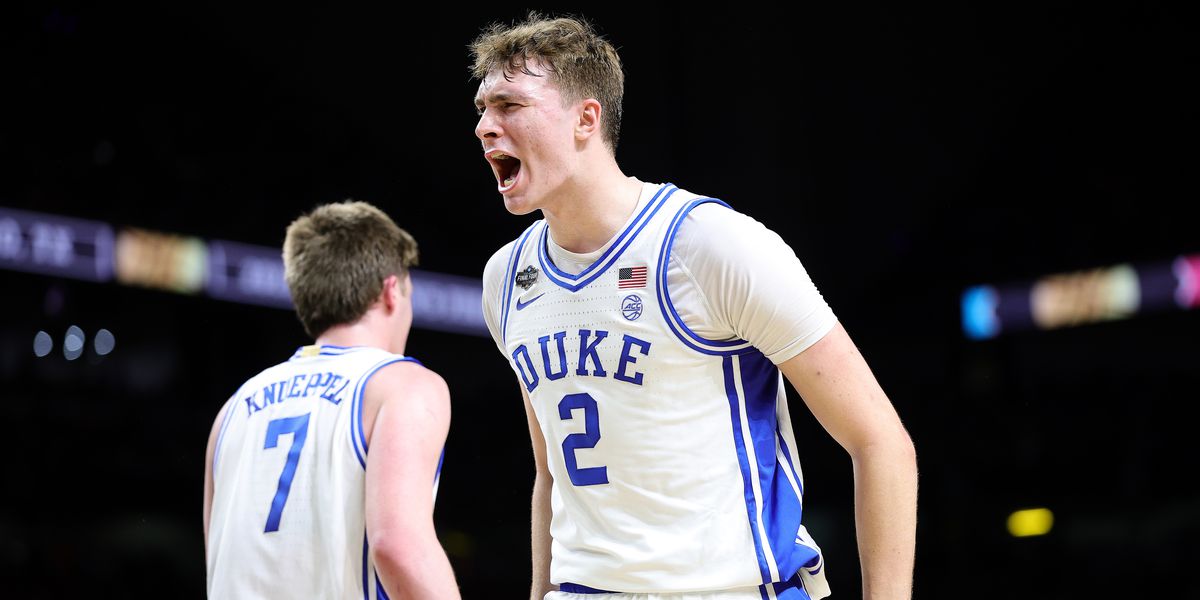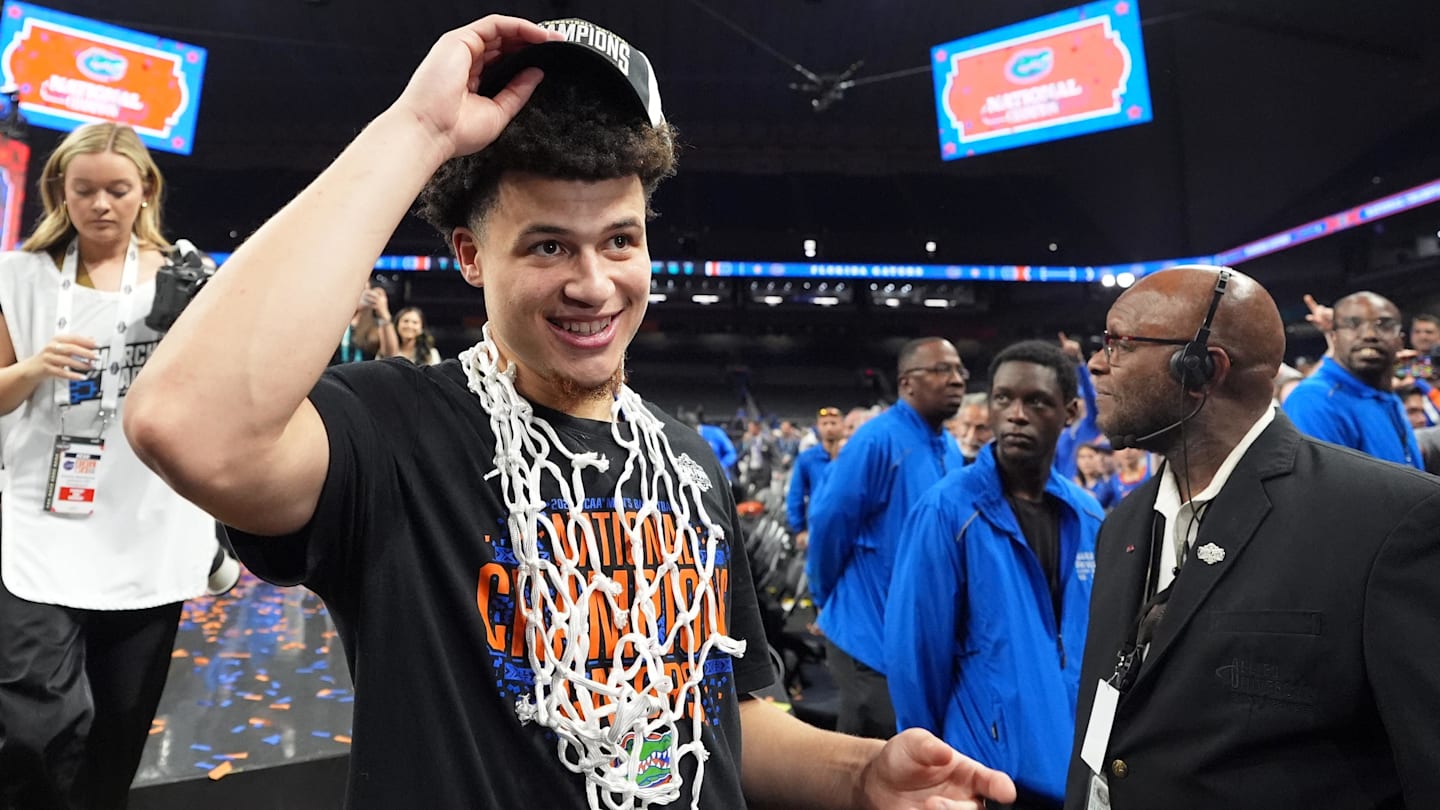
With the NBA Lottery just weeks away, Sixers fans are back to watching the odds. Right now, there’s a 63.9% chance they keep their first-round pick, which would go to the Oklahoma City Thunder if it falls outside the top six. But as any fan knows, lottery night is anything but predictable.
That randomness only adds to the buzz around the 2025 draft, which is looking like one of the deepest in years. There’s real star power up top — from skilled wings to polished bigs —and teams have a shot at landing a true difference-maker.
At the top, four names are starting to separate from the pack. Here’s how I’d rank them right now:
1. Cooper Flagg, SF/PF, 6’9, 205 lbs
It’s tough to make a valid argument against Cooper Flagg as the crown jewel of this draft class — and I’m not about to try. He sits atop just about every major draft board, and for good reason. Flagg is as complete a prospect as we’ve seen in years, with virtually no glaring weaknesses on either end of the floor.
During his lone season at Duke, Flagg answered two of the biggest questions surrounding his game: shooting and shot creation. In 37 games, he knocked down 38.5% of his threes on 3.6 attempts per game — a strong number that speaks to real growth and confidence from deep. While his handle could still use some tightening, he showed a consistent ability to create his own shot and proved he’s more than capable of getting buckets without relying on others.
Outside of those early concerns, Flagg’s game is as polished as they come. He’s a force on the defensive end, averaging 1.4 steals and 1.4 blocks per game, with the size, athleticism, and instincts to be a versatile stopper at the next level. He’s already shown the ability to guard multiple positions and switch seamlessly across the floor — traits that make him a dream fit in today’s NBA defenses.
Flagg has all the tools to be a game-changer on defense, but he also stepped up as Duke’s go-to scorer in key moments. Offensively, he uses his size to his advantage, showing the ability to finish through contact at the rim while also knocking down shots from the perimeter. He’s reliable at the line, too, converting 84% of his free throws on a strong volume, yet another sign of his polish and poise under pressure.
Flagg is still just 18 years old, with plenty of runway left to develop, but he’s already proven himself as the best prospect in this class. Despite his youth, he plays with a maturity beyond his years and should be able to contribute from day one in the NBA, all while offering elite long-term upside.
2. Dylan Harper, PG/SG, 6’6, 220 lbs
If Flagg weren’t in this class, there’s a strong case for Dylan Harper as the projected No. 1 pick. The Rutgers standout has an ideal frame for a lead guard at 6-foot-6, paired with a polished offensive skill set. Harper excels at creating his own shot, showing advanced footwork, elite body control, and a natural feel for scoring from all three levels.
Most young point guards tend to struggle with decision-making and reading the game at speed, but that’s not the case with Harper. At Rutgers, he consistently made smart, composed reads, showing maturity beyond his years. Despite a high usage rate and heavy minutes, he maintained a relatively low turnover rate, a testament to his poise and control as a floor general.
The biggest knock on Harper’s game is his lack of elite athleticism — his explosiveness and top-end speed are average at best. But that hasn’t held him back, particularly on the defensive end. He consistently played with effort and poise, moved his feet well, and showed a strong ability to navigate screens. He may not be a freak athlete, but he more than holds his own thanks to his instincts, discipline, and physical frame.
Harper might not have the highest ceiling in this class — a key factor when you’re considering a top-three pick — but he arguably has the highest floor outside of Flagg. Guards this refined, this early, are a rare find. With his size, feel, and maturity, Harper should be the first name called after Flagg — and whichever team lands him will be getting a ready-made contributor with long-term starter potential.
3. V.J. Edgecombe, SG, 6’5, 180 lbs
You can just about pencil in Flagg and Harper at the top two spots, with the real intrigue of the draft beginning at No. 3. My opinion on this has evolved quite a bit, but for now, I’d slot Baylor’s V.J. Edgecombe in.
My thinking here is to go with the player who has the highest upside — and outside of Flagg and Harper, that’s Edgecombe. He has an NBA-ready frame, and every conversation about him begins with his elite, fluid athleticism. At 6-foot-5, he’s a quick, explosive guard with broad shoulders and a lightning-fast first step that allows him to blow by defenders and get to the rim with ease.
Edgecombe is a well-rounded scorer with excellent driving ability and a steadily improving jump shot. In his lone season at Baylor, he shot a solid 34 percent from three on a healthy volume of 4.6 attempts per game. His shooting mechanics are fundamentally sound, and with a few minor adjustments, he projects as a capable and confident perimeter shooter.
Edgecombe is also one of the top defensive prospects in this draft class. He boasts a high defensive IQ, which shows up in the box score with 2.1 steals per game. Though primarily viewed as a guard, he also displays impressive timing and instincts as a shot blocker, recording 20 blocks in 33 collegiate games.
The primary concerns surrounding Edgecombe center on the refinement of his overall game. While he’s capable of putting the ball on the floor, his handle still needs tightening, especially when facing higher-level defenders. Much of his current success relies on his physical tools — his frame and athleticism — rather than finesse or polish. However, with the right development and coaching, improved skill work combined with his elite physical traits could make him a highly valuable two-way player.
Edgecombe may not be the third-best player in the draft right away, but his physical tools, paired with his proven production, make a strong case for him at the No. 3 spot. He possesses natural abilities that you can’t teach, and with continued development, his ceiling could be among the highest in the class.
4. Ace Bailey, SF/PF, 6’10, 200 lbs
Rounding out the top tier is Harper’s teammate at Rutgers, Ace Bailey. Once widely regarded as a top-two prospect heading into the season, Bailey has gradually slipped down draft boards. Still, I have him closing out the elite group in the 2025 class — and in my opinion, whichever team lands him at No. 4 is getting excellent value.
So, why has Bailey slid to the fourth spot on my board? There are a few reasons. He relies heavily on his jumper, which has produced mixed results. His tendency to settle for contested shots, combined with an inconsistent ability to create his own offense, has impacted both his individual efficiency and his team’s flow. His handle needs refinement, and his playmaking can be limited, often struggling with tunnel vision when attacking or looking for his shot. I would argue that his passing isn’t as bad as some have advertised or the box score suggests, but he’ll certainly need to improve this aspect of his game.
Despite his ideal frame, Bailey has been fairly average on the defensive end. He’s shown flashes as an off-ball or help defender, but his on-ball defense remains inconsistent, and he can be found ball-watching or being out of position. Compared to someone like Edgecombe, Bailey struggles to consistently impact the game beyond scoring and rebounding, which is a concern in today’s NBA, where well-rounded skill sets are increasingly valued.
That said, there’s still plenty to like about Bailey’s game — especially if he falls outside the top three. At that point in the draft, his upside and scoring potential represent excellent value. He brings strong physical tools to the forward position, with good length, decent size, and athleticism. He covers ground quickly with long strides and excels in transition. Offensively, he has a smooth midrange pull-up and intriguing potential as a post scorer. Thanks to his length, size, and high release point, he’s capable of getting tough shots off even against tight defense.
The key to Bailey unlocking his full potential lies in refining his basketball IQ, tightening his handle, and consistently getting into the paint. If he’s able to develop in those areas, there’s a real path for him to emerge as a top player in this draft class.
Opinions can shift, injuries can happen, and the draft landscape can change quickly depending on how the lottery plays out. Still, one way or another, it feels increasingly likely that Flagg, Harper, Edgecombe and Bailey will be the first four prospects off the board — in some order. How teams prioritize upside, fit and versatility will ultimately determine the sequence, but the top tier is starting to take shape.


